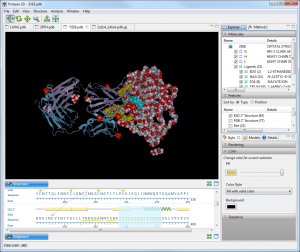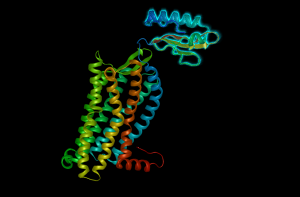NovaFold and Custom Template Libraries
A modern, flexible approach to protein modeling
 Need to predict the 3D structure of a protein based on its amino acid sequence? That’s a job for NovaFold, our protein modeling application, available to use with Lasergene Protein. Built on the award winning I-TASSER algorithm for protein modeling, NovaFold uses a hybrid threading and ab initio algorithm for protein modeling. The threading component models structure fragments from multiple templates from the Protein Data Bank (PDB).
Need to predict the 3D structure of a protein based on its amino acid sequence? That’s a job for NovaFold, our protein modeling application, available to use with Lasergene Protein. Built on the award winning I-TASSER algorithm for protein modeling, NovaFold uses a hybrid threading and ab initio algorithm for protein modeling. The threading component models structure fragments from multiple templates from the Protein Data Bank (PDB).
But what if you want to use a custom set of templates for running those folding predictions? That’s where our new “custom library” service comes in. With custom libraries, you can limit the templates to a specified subset of protein structures from the PDB, a set of proprietary protein structures, or a combination of the two.
In this article, we’ll explain how this service works and who might benefit from it. But first, let’s look at why a user may want to use NovaFold and Lasergene Protein for protein structure prediction in the first place.

Why use NovaFold for protein modeling?
NovaFold uses the award-winning I-TASSER algorithm, but with many advantages:
- NovaFold is wrapped in an easy-to-use software package, so no programming or scripting knowledge is needed. Just answer a few questions and upload the sequence you want to fold, and NovaFold goes to work.
- NovaFold results are opened directly in Protean 3D, part of Lasergene Protein, so you have full access to interactive model structures and reports in a centralized software application. The software also allows for easy downstream analysis of structure models. For example, you can easily align predicted structures to each other or to the templates used for modeling, apply surfaces, and see secondary structure characteristics using interactive views.
- NovaFold allows you to submit multiple jobs at once, reducing the amount of hands-on time needed to manage protein modeling runs.
- NovaFold is the only protein folding software to offer an Enhanced Conformational Search option. If this option is chosen, NovaFold enhances the structural diversity of the normal template set. For templates selected by protein threading, DNASTAR’s proprietary process samples alternate structural conformations and replaces a subset of the templates with lower energy conformations.
- NovaFold can be run on the cloud or on a local server, giving you flexibility and choice in how you manage your protein data and computer resources.
- NovaFold is supported by DNASTAR, giving you peace of mind that you can have your questions answered by experienced scientists and bioinformatics experts should issues arise. Beyond technical support, DNASTAR also offers services like custom library support for a truly customizable protein modeling platform.
NovaFold is available to purchase online as part of Lasergene Protein. Special pricing is available for academic, government, and non-profit researchers.
Why would a NovaFold user consider using a custom structure library? What’s wrong with just using the standard NovaFold libraries?
NovaFold includes a standard library that works great for most folding predictions. The standard library is a clustered and reduced version of the PDB, so it contains representatives of different protein folds. By contrast, custom libraries are smaller and provide higher redundancy. For example, we can specify that a user’s private or proprietary structures either supplement or supplant the standard template structures.
There are several reasons a researcher might want to use a custom library. For instance, custom libraries can greatly reduce the computation time needed to make folding predictions. In addition, the redundancy in a custom library allows a researcher to find the best template for a protein, not just the best representative.
People most likely to benefit from this new service are pharmaceutical researchers and those doing academic research in the field of protein chemistry; especially those studying the structure of a particular protein fold or family. Small, focused custom libraries are particularly useful for those studying kinases, antibodies with unique topologies, or G-protein-coupled receptors (GPCRs).

What’s the process for creating a custom template library?
First, customers need to have a current license for both Protean 3D and NovaFold. Second, they will need to provide our Lasergene Protein team with a set of PDB files or describe the criteria we should use for selecting structures from the PDB database. Depending on the number of entries, DNASTAR needs a few days up to several weeks to create the custom library.
Case Study: Modeling GPCR Structures with Custom Libraries
 To illustrate one potential use case for this workflow, we’ve created a custom library from 350 GPCR structures from the Protein Data Bank to model a new GPCR structure. Due to lack of similar structures in the PDB, the portion of the extracellular subdomain was also modeled independently using the standard NovaFold library. The two models were then aligned to create a hybrid model of the entire structure. Using the NovaFold reports, GO term functionality, similar structures and ligand binding sites were also found using the Coach and CoFactor methods to help identify the function of the extracellular part of the GPCR. By combining multiple modeling methods and template libraries, NovaFold can generate a more complete picture of the protein structure than attainable through standard libraries and modeling methods alone.
To illustrate one potential use case for this workflow, we’ve created a custom library from 350 GPCR structures from the Protein Data Bank to model a new GPCR structure. Due to lack of similar structures in the PDB, the portion of the extracellular subdomain was also modeled independently using the standard NovaFold library. The two models were then aligned to create a hybrid model of the entire structure. Using the NovaFold reports, GO term functionality, similar structures and ligand binding sites were also found using the Coach and CoFactor methods to help identify the function of the extracellular part of the GPCR. By combining multiple modeling methods and template libraries, NovaFold can generate a more complete picture of the protein structure than attainable through standard libraries and modeling methods alone.
To learn more about how custom libraries could fit into your research or to receive pricing information for this service, please contact sales@dnastar.com.


Leave a Reply
Your email is safe with us.